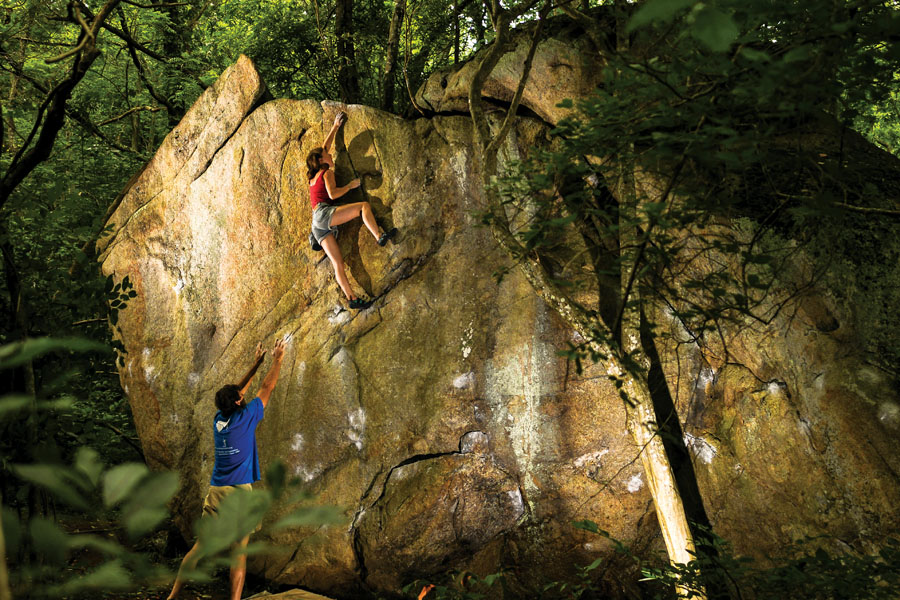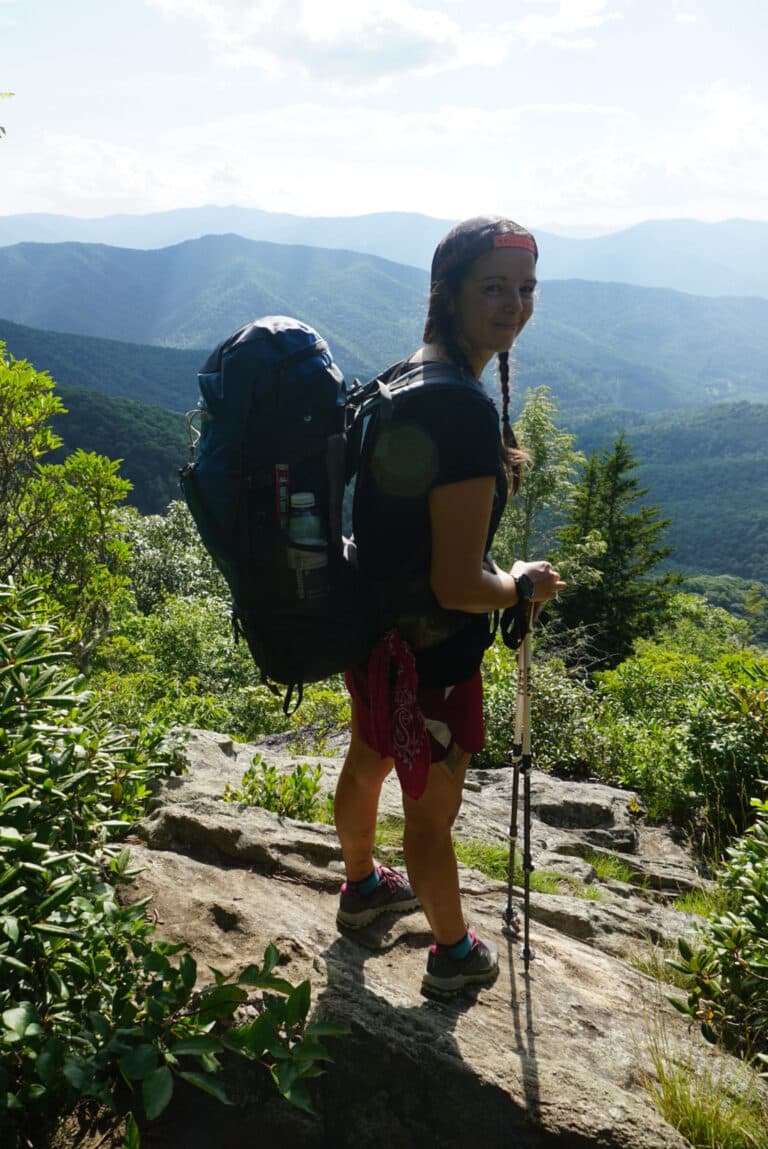It’s a cool morning in late April 2017. A group of climbers and representatives from the Blue Ridge Conservancy and the Carolina Climbers Coalition (CCC) meet about 10 miles west of Boone, N.C., at the entrance of a 55-acre chunk of pristine forest. They spend the day walking beneath the formidable boughs of an ancient canopy, wrestling centuries-old groves of rhododendron in search of rock.
Local Joey Henson is leading the way. An Appalachian State University alumnus, Henson has been climbing in the High Country for over 30 years. The property, known as the Farthing Tract or Buckeye Knob, is Henson’s backyard. His own land has long served as basecamp for visiting climbers and butts up to the Barn Boulders, a boulderfield adjacent to Buckeye Knob where climbers have enjoyed unofficial access since the ‘90s.
“I’ve been climbing in Boone since the late ‘80s and I had never been to Buckeye Knob or the Barn Boulders until this year,” says Brian Payst, president of the CCC. “That’s the cool thing about Boone. There are tons of rocks hidden in the woods. The boulders at Buckeye Knob are tucked into the canopy. If you were to drive down the road you would have no idea there were any boulders.”
Payst is also along for the reconnaissance mission, which effectively decided the fate of the Farthing Tract in an afternoon. Just this past winter, Highland Forestry, Land & Timber had purchased the property, but put it back on the market soon after. When Henson got wind that the Farthing Tract was for sale, he wasted no time in rallying the troops.
“It wasn’t just climbers but hikers, amateur archaeologists, forest lovers in general,” says Henson. “There were a lot of people for a long time prepping for what would happen when it went on the market, which it did suddenly this year, and we were ready for it.”
Heavily forested and laced with mountain-fed springs, the Farthing Tract is prime real estate. It’s home to the headwaters of the Bear Creek watershed, which eventually feeds into Cove Creek and the Watauga River. Along the creek, researchers have unveiled Paleolithic-age artifacts and footpaths. Million dollar views of Grandfather Mountain, Roan Mountain, Mount Rogers, and Mount Mitchell are visible from the mesa-like summit of Buckeye Knob (4,350 feet).
Climbers are of course drawn to the boreal forest for its dense concentration of granite boulders, 180 of which are known and have 500 problems established already. Between the legendary ascents of world-renowned climber Chris Sharma and the continued vertical feats of Triple Crown Bouldering Champions Taylor McNeill and Becca O’Brien, these boulders have been climbed by some of the highest-level athletes in the sport. But most impressive of all are the trees, which have stood the test of time, untouched by man.
A pretty penny could be made here from logging or development, but Henson couldn’t bear to see that happen. Fortunately, neither could David Isner, owner of Highland Forestry, Land & Timber.
“It could have been done,” says Isner about logging the land. “I had arranged for suitable, serviceable access into the property for timbering purposes. Had I done that, that would have been a fine use for the property, but I could see it would negate the recreational use that Joey and others were very interested in having this property available for. They could see a pathway where this land could be used for conservation and recreation, and I don’t get to see that opportunity very frequently on the mountaintop properties I provide timbering services to.”
In fact, Isner has never worked with a non-profit for both conservation and recreation purposes. He admits to being skeptical at first, but by June 28, 2017, two months after that walk in the woods, Isner, the CCC, and The Access Fund had signed a contract. The deal closed last month on September 18, marking the first Boone area acquisition by climbers, for climbers.
“We’ve been seeing access open up at Grayson Highlands, Hidden Valley, Breaks Interstate Park, Rumbling Bald, but it’s like we’ve drawn a circle around the High Country,” says Aaron Parlier, founder of Boone’s climbing gym Center 45. “Now it’s happening here, and I can’t say for sure, but I have to foresee that as being an extremely positive move in the right direction.”
Boone’s climbing history is fraught with tenuous access, lost at the hands of bulldozers and petty deeds. Locals still have a sour taste in their mouths about areas like the Mildred Boulders on Grandfather Mountain and Howard’s Knob, a privately owned downtown boulderfield that climbers unsuccessfully attempted to purchase back in 2010. Parlier says those losses wore heavily on the community, and for many years the climbing culture felt unapproachable for out-of-towners and newcomers to the sport.
“When those closures were happening, it understandably created this idea that more people visiting meant more impacts and more closures,” he says. “There was a locals-only stigma in place, and some of that remnant clandestine outlook is still around, but I feel like it was very short lived. This Buckeye Knob acquisition is really a turn of events that hopefully opens the doors for folks who want to come to the High Country and climb.”
Today, the vast majority of bouldering in Boone, such as Blowing Rock, Highway 221, Grandmother Mountain, and Lost Cove, is all found on either National Park Service land or Forest Service Land. Current relations between these land managers and climbers are better than ever, but access to these major climbing destinations isn’t officially recognized.
“It really is a handshake agreement for the time being,” says Payst. “Considering the amount of climbing in Boone, it’s kind of amazing that there is no management. It’s just a matter of time before the Forest Service recognizes climbing as a legitimate recreational activity that needs to be managed that way.”
The CCC and the Access Fund have been working on a memorandum of understanding with the National Park Service for several years, but it’s currently tied up in legal limbo. Payst, Henson, and Parlier are hopeful that the success of the Buckeye Knob acquisition will only continue to prove climbers are responsible stewards and land users.
The purchase of Buckeye Knob by the Access Fund and the CCC has since led to a domino effect of land donations and easements on four adjacent properties, including Audubon Society and Blue Ridge Conservancy “forever wild” lands. All told, climbers now have permanent access to 190 acres of boulder-strewn forest.
Unlike other climbing areas in Boone, which are predominantly metamorphic sandstone, quartzite, and amphibolite, the Buckeye Knob and Barn Boulders are granitic gneiss and resemble rock found in western bouldering destinations like Leavenworth, Wash., and Bishop, Calif. The freestanding, egg-shaped boulders are literal works of art, colored every shade of bronze and pink and peach with streaks of stark black veins.
With naturally flat, clear landings and an unexplainable tendency to be completely dry when other parts of Boone are socked in (Henson calls it Boone’s “rain shadow”), Buckeye Knob and the Barn Boulders could very well prove to be the most significant bouldering area in the High Country. Novice boulderers will find plenty of climbs on the V1 thru V3 40-problem circuit, while climbers looking for a project and a lesson in humility should look no farther than the Woodruff Boulder, a behemoth of a rock with 10 V10s.
“Buckeye Knob is the land of adventure and exploration,” says Henson. “You can still get lost up there. We want climbers to recognize how pristine this land is and not love it to death. This area provides a gateway for other western Watauga County features, and our hope is to get the county and private sector involved to see climbing as the economic engine it is.”
The CCC is currently raising funds for the Buckeye Knob purchase. Help them meet their $145,000 goal by making a donation at carolinaclimbers.org/buckeyeknob. You can also participate in the Hound Ears portion of the Triple Crown Bouldering Series on October 7th, which will also serve as a fundraiser for the acquisition.







